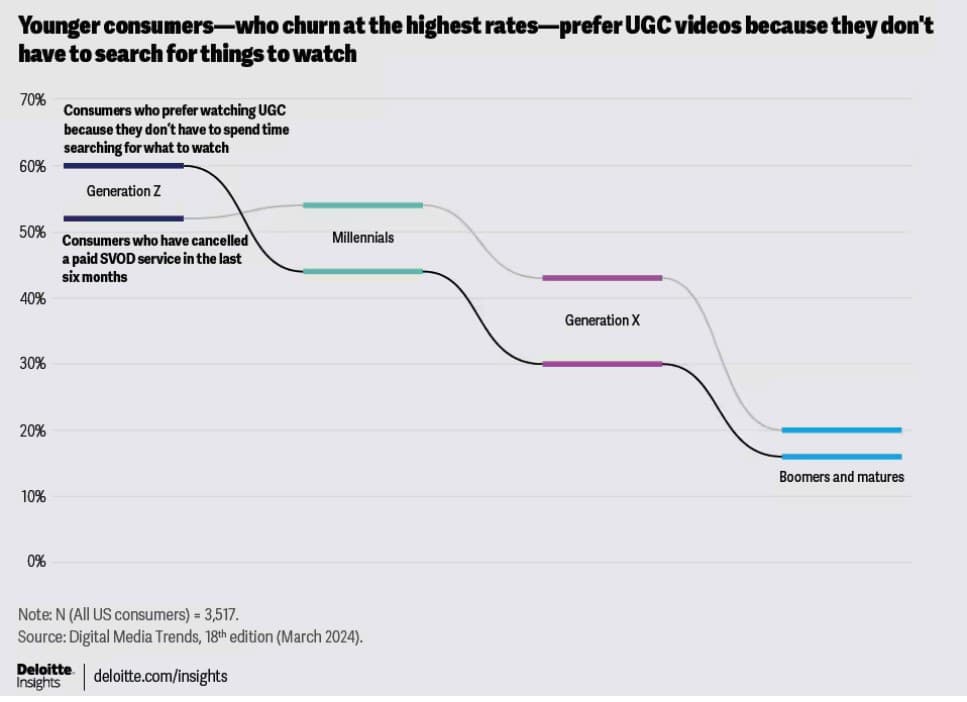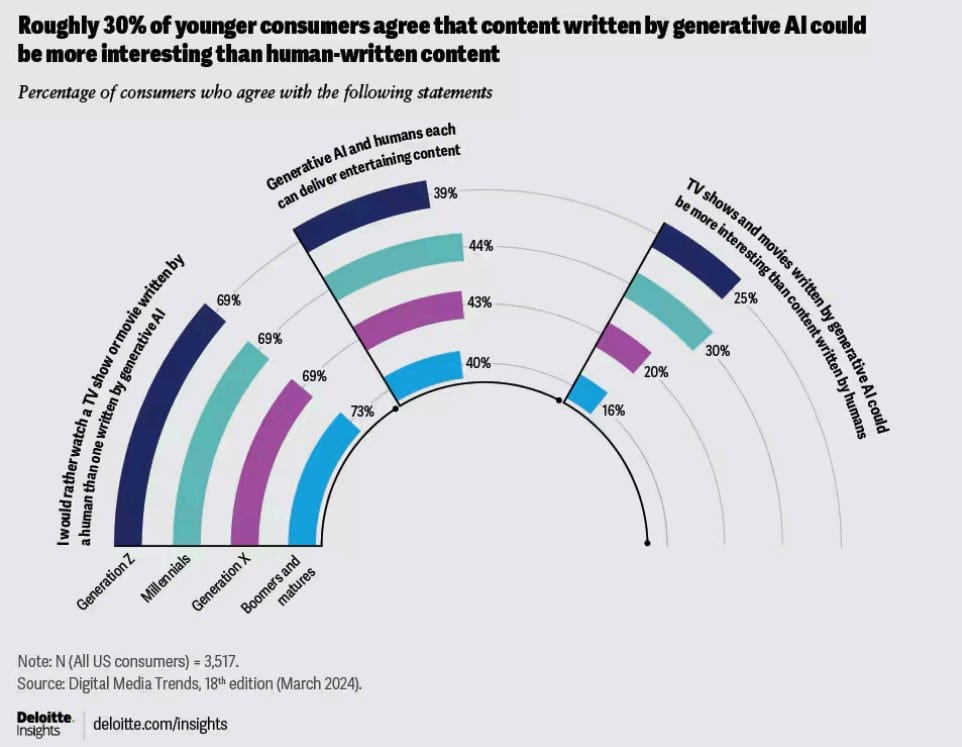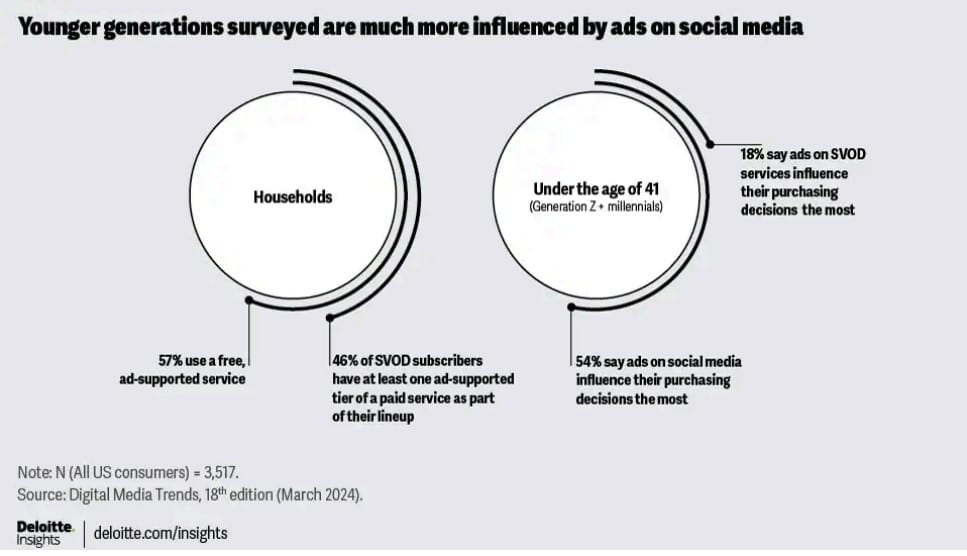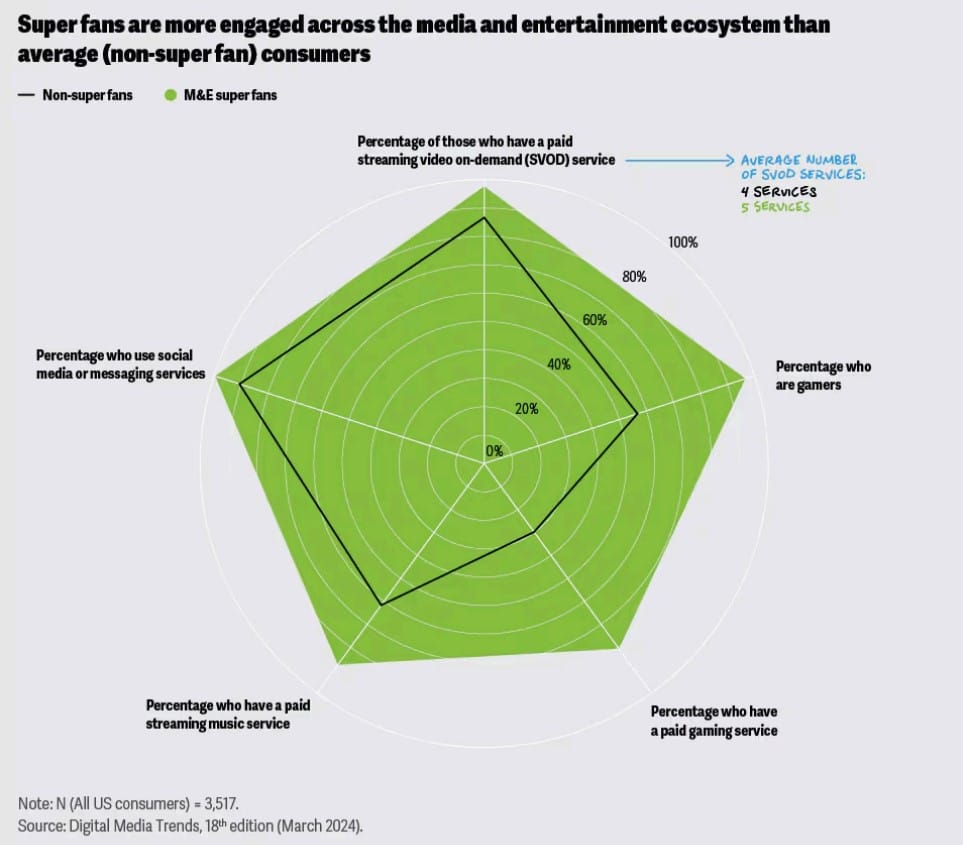American consumers’ evolving needs, behaviors, expectations and demographics—particularly those of Gen Zs and millennials—are continuing to influence the media and entertainment (M&E) industry, and new research from Deloitte takes a deep dive into how these shifts in consumer interests, attitudes and identities are impacting digital media.
Insights and data from the firm’s 18th annual Digital Media Trends survey provide an understanding of these digital media trends, from which M&E brands can better position themselves to build profitable business models and confidently operate in a constantly changing landscape.

Revolutionizing engagement and discovery in modern media
The growth of the creator economy and social entertainment is reshaping media, and steering user preferences and expectations for discovering content in the process. Social media platforms compete for audience attention but also offer M&E companies vital marketing avenues. These platforms and their creators are becoming important in driving viewership and engagement across various digital services. While M&E companies have traditionally aimed at broad audiences, they should also consider the untapped potential of segmented, hyper-engaged fan communities. These fan communities are highly valuable—offering a multi-channel strategic opportunity because they engage intensely both online and offline.
- Underscoring the growing importance of UGC videos in shaping media consumption habits, 60 percent of Gen Zs surveyed say they prefer watching UGC videos because they do not have to spend time searching for what to watch.
- Creators and UGC videos often point consumers, particularly Gen Zs and millennials, to content and influence their purchasing decisions; of this group, almost half of those surveyed (49 percent) watch TV shows and movies after hearing about them from creators online, over half (55 percent) find out about new game titles from live-streamers and content creators on social media and over half (54 percent) say advertisements on social media influence them most.
- Fandom is uniquely tied to consumers’ identities and can influence spending habits. About 40 percent of consumers surveyed say that their fandom for their favorite music artist is important to their identity—and these music fans are more likely to pay for a music subscription and attend live music concerts. Movie fans (26 percent) and video game fans (21 percent) also say their fandom for movies and video games, respectively, is important to their identity.
“Our research underscores a fundamental shift in the media landscape. Social media platforms are not merely competitors; they can be influential collaborators for media companies as they aim to captivate and maintain audience engagement,” said Kevin Westcott, vice chair, Deloitte LLP and U.S. technology, media and telecom leader, in a news release. “The power of social media and content creators extends beyond content dissemination—they are often the new vanguards of taste, influencers of choice and architects of community engagement. As we delve deeper into this era of digital entertainment, the synergy between traditional media and emergent digital platforms will likely be paramount in shaping a business model that resonates with an ever-evolving, diverse audience base.”

Consumer interests, attitudes, and identities are shifting
Gen Zs and millennials are often early adopters of new trends like social media, video games and streaming video. These generations are more diverse and have unique backgrounds and identities. They expect content that is inclusive and reflects the diversity they see in the world around them. For instance, the gaming industry is often perceived to cater more to men and boys. This may limit growth in gaming, especially for live service games that have been challenged by harassment and bullying. To remain relevant and effectively engage with all audiences, M&E companies should invest in creating content that reflects and supports the increasingly diverse society we live in.
- More than half of Black consumers prefer to watch TV shows and movies that feature people who look like them. And the team behind the scenes matters, too: Nearly 70 percent of Black consumers surveyed—and more than half of Asian, multiracial, and Hispanic and Latinx consumers surveyed—say it’s important to them that TV shows and movies are written and produced by diverse creative teams.
- Diverse audiences are more likely to think that social media videos are much more diverse than TV shows and movies. More than 40 percent of consumers surveyed overall find social media videos much more diverse than TV shows and movies—a figure that increases to 60 percent among Gen Zs and to over 50 percent for Black, multiracial, Hispanic and Latinx, and LGBTQIA+ respondents.
- Approximately 60 percent of Americans surveyed spend an average of nine hours per week playing video games. Men and women may have different gaming experiences. About 30 percent of men who play games consider bullying to be part of the experience, but only 19 percent of women gamers surveyed feel the same way. Consequently, almost half of men gamers say they spend most of their gaming time playing one or two live service games, but just 29 percent of women gamers do so.

Streaming video business model at a crossroads
The survey reveals that the future of streaming video is at a turning point as traditional models struggle to meet consumers’ evolving expectations. Simply repackaging the pay TV experience—using advertising revenues to reduce subscription costs, increasing bundles, and offering reduced rates for year-long contracts—may not be enough for streaming video on demand (SVOD) providers to combat churn. Gen Zs and millennials are less influenced by commercial advertising (which tends to be repetitive and not personalized) and look to social media creators and influencers for discovery and recommendations. However, SVOD providers may be able to increase engagement by delivering more personalized experiences and expanding their presence and influence across social and gaming platforms.
- Price hikes may be approaching their peak. On average, subscribing households surveyed spend $61 per month for four services, up from $48 per month last year. However, almost half (48 percent) of respondents say they would cancel their favorite paid SVOD service if monthly prices went up $5.
- Churn (or the percentage of consumers who have canceled any paid SVOD service in the previous six months) has softened a bit to 40 percent (down from 44 percent last year), suggesting that tiering and even bundling may be helping with retention. Sixty-seven percent of respondents want a bundle to search for content across all their services, and the ability to customize it is key; 63 percent indicate they would like a bundle of services that they can customize each month.
- Traditional ads on streaming video services are not proving to be influential, especially for younger generations. Of those surveyed under 41 years old, just 18 percent say advertisements on SVOD services influence their purchasing decisions.
- Viewers find it too hard to find the content they want. Almost 50 percent of consumers surveyed would spend more time on streaming video if it was easier to find content, and more than half of those surveyed age 41 and under believe they get better recommendations for content to watch from social media than from streaming services.

“Streaming services have reached a pivotal moment. Delivering great content is no longer enough—curating a more personalized experience designed to better match content with personal preferences and interests is the next step,” said Jana Arbanas, vice chair, Deloitte LLP and U.S. telecom, media and entertainment sector leader, in the release. “And it’s important to recognize that social media is the primary way people discover and get excited about entertainment. For content to resonate and drive engagement with consumers, streaming video providers should work to ensure their content connects with their diverse audiences and fosters a sense of community and social connectivity.”
Download the full report here.
The “Digital Media Trends,” 18th edition, survey was fielded by an independent research firm in October 2023 among 3,517 U.S. consumers, ages 14 and older.







